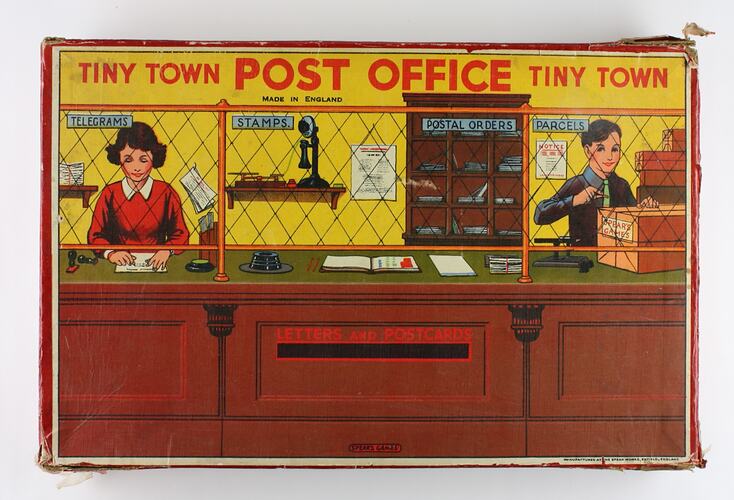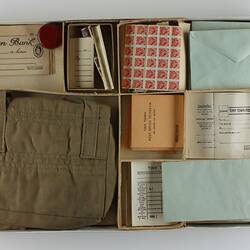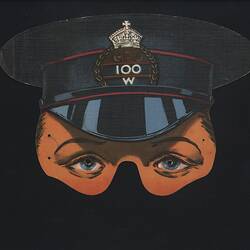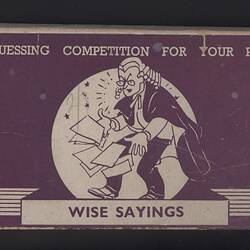Summary
Children's game of post office, comprising a box of miniature postal accessories. It was made by Spear's Games, England. It may have come from the shop of 'Tim the Toyman', who had a toy shop in Regent Arcade, and lived opposite the donor's home. She remembers receiving Stief toys and other toy gifts from his shop.
The donor, born in 1939, explained that the games she and her friends often played as children reflected the world around them - such as playing post office. Their post office game involved taking on different roles - customer, person working behind the counter or postman. The donor remembers having to be very careful when playing with the post office game, often play-acting the postage process rather than actually using the set (ie. not writing on letters or sticking stamps). She remembers, though, sometimes writing letters to playmates using the tiny envelopes.
The donor was interested in correspondence, and says that 'The very first letter I received - apart from the ones sent to me by a fairy and posted in the ivy by her aunt - began "Thank you for asking you mother to write to tell us how much you enjoy Kindergarten of the Air....." I was hooked early on.' Enid Blyton later wrote to her - sending a picture and a card, probably in response to a letter sent to Enid by the donor or her mother regarding enjoyment of Enid Blyton books.
Physical Description
Children's game in cardboard box with lid. Box features coloured image, painted and drawn, of a post office desk. Two children (acting as adults) stand behind a grille above the counter, beneath the label 'TINY TOWN POST OFFICE'. The boy opens a box labelled 'SPEAR'S GAMES'; the girl is writing. Ledger books, stamps, pigeon holes for letters and a telephone are amongst the accessories which complete the post office scene. Within the box lid is extensive instructional text. Within the box are a series of miniature accessories for children to play 'post office': a cardboard facade (same images as on box lid) with slot for posting letters, which is bent to allow it to stand; stamps in sheets (some individually); envelopes; mail bag; cheques; money orders; telegraph forms; telegram envelopes; postcards; postal orders; stamp pad; paper money; and a mask with upper part of a postman's head with cap, with eyeholes. While much of the set has not been used, a few of the documents and an envelope have been repeatedly ink-stamped and pasted with stamps.
Significance
The significance of this game lies in both its completeness and its provenance. Although children have played with the game, the individual components remain largely intact, documenting both the original game and postal practice (at least in England, where the game originates) in the 1940s.
The provenance of the game is well-documented. The donor was born in 1939 and had a younger brother born in 1941. They grew up in a house built by her parents, in a court of four houses - a subdivision at the back of a large Victorian house in Hawthorn. The court was a dead end, and the eight local children of the court, born between 1938 and 1941, all played together in the street - cricket, hopscotch, hide and seek, and learning to ride bicycles in each others' back yards. Each house had a sandpit.
Her father served in Queensland during World War II until she was five years old, as did some other neighbours' fathers. The family grew vegetables in the back yard during and after the War. Her mother had studied commerce at the University of Melbourne, but did not complete her degree. She went instead to the Invergowrie Homecraft Hostel in Hawthorn to learn housekeeping skills. She stayed at home after marriage but wrote entertainments and little plays and worked in radio, and had a brief career in the early days of television. She was something of a frustrated actress and artist. Her father had a degree in agricultural science but became an accountant.
The donor remembers playing many imaginary games involving performances. She and her best friend had a puppet theatre and painted the scenery in her laundry. She ran a radio station in her lounge, and choreographed a ballet with her friend. She also 'ran' a school on the back of her father's truck, with a school motto and a school song. She remembers being taken to the theatre for birthdays starting from the age of five and children's theatre - Joan and Betty Raynor - in her school holidays; and sometimes the 'pictures'.
She and her friends all listened to the Children's Session on the ABC - the donor was a member of the Argonauts Club, part of the Children's Session. In the winter their cue for the start of the Children's Session was when the street light (which doubled as a wicket) came on at 5.20. In summer the street light went on at 8 - time to go home to bed.
Gender divisions were clear in some games. Girls generally didn't play football. In the sandpits, boys made racetracks while the girls made sandcastles. The donor remembers playing with knucklebone jacks - using real knucklebones. She also remembers playing tea parties, and still has her doll's house, made by her grandfather during World War II. She learned knitting from her mother - all the local mothers knitted - and knitted clothes for her dolls. She made a doll at school with a papier maché head, and made scrapbooks of the Royal Family.
The donor later went to university and worked for the ABC for 28 years, starting in the 'Talks' department.
Other sources also mention playing with the post office game. Tracey Harvey, interviewed by Gwenda Davey for the Talking Chair display at Museum Victoria (18 November 1988), said 'I loved that, oh we actually got the proper postie kit one year, but and that of course had the very special little envelopes, and pieces of paper and a little cardboard letterbox, and my sister and I would write letters to each other and then you'd wait, to see if there was a letter in your letterbox and you'd open it up, and the exhilaration of getting this letter, in your letterbox, was fantastic and I guess, with the little envelope and the notepaper.
'But that led onto, my father used to take correspondence courses for people learning to draw, through Stott's, and people would send him cardboard tubes with their drawings in them, of cylinders and all sorts of geometric shapes, and he would JUST mark them and send them back. So my sister and I used to draw our own pictures and then send them to Dad as well, to be marked, only we didn't buy stamps, I think we just used to put them in the letterbox, but you know, and then Dad'd receive them, and he'd unwrap them, and that was really, great fun, and I think the thing of, in receiving something in the letterbox is very special, isn't it...'
More Information
-
Collecting Areas
-
Acquisition Information
Donation from Gillian McLeod, 30 Oct 2010
-
Place & Date Used
-
Inscriptions
On box, printed: 'TINY TOWN POST OFFICE TINY TOWN / MADE IN ENGLAND'. Extensive text inside lid.
-
Classification
-
Category
-
Discipline
-
Type of item
-
Overall Dimensions
364 mm (Width), 28 mm (Depth), 238 mm (Height)
Box size
-
Keywords




